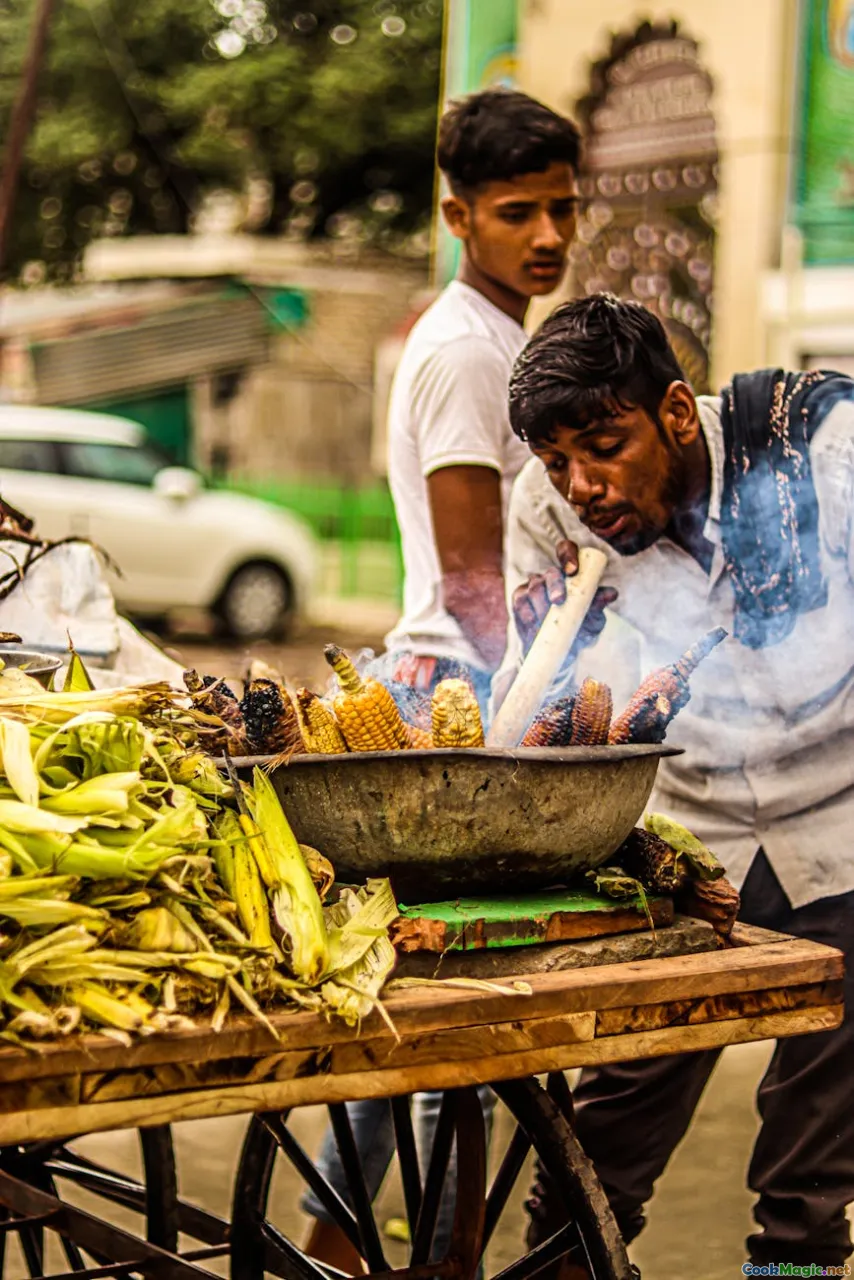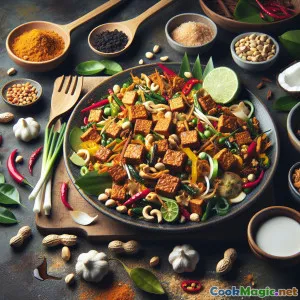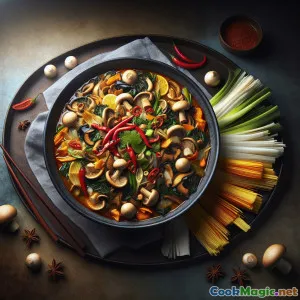
Bakwan Jagung Pasar Pagi: Kruche indonezyjskie placki z kukurydzy
(Bakwan Jagung Pasar Pagi: Crispy Indonesian Corn Fritters)
(0 Recenzje)0
1,168
lipiec 21, 2025
Zgłoś problem
Składniki
-
2 cobs (about 220g shelled) Świeże ziarna kukurydzy
(Można użyć mrożonych lub konserwowanych produktów, jeśli świeże nie są dostępne.)
-
50 grams Mąka ryżowa
(Dodaje chrupkość; można użyć mąki uniwersalnej zamiast tego.)
-
50 grams Mąka uniwersalna
(Mieszanka tworzy lekką i chrupiącą teksturę.)
-
1 large Jajko
(Pomiń dla wegan; użyj zamiennika jajka z lnu.)
-
2 stalks Szczypiorek
(Cienko pokrojone dla ostrości)
-
1/2 medium (about 40g) Marchewka
(Pokrojone w julienne, opcjonalne, ale zalecane dla koloru i słodyczy.)
-
1 small Czerwona chili
(Drobno posiekane, dostosuj do swoich preferencji ostrości)
-
2 cloves Czosnek
(Drobno posiekane dla pogłębienia smaku)
-
2 tbsp Liście kolendry
(drobno posiekane, świeże, opcjonalne)
-
1/2 tsp Sól
(Do smaku)
-
1/4 tsp Czarny pieprz
(Można użyć czarnego pieprzu)
-
75 ml Mleko kokosowe
(Gęsty lub rzadki; można zastąpić wodą, aby uzyskać łagodniejszy smak.)
-
250 ml Olej roślinny
(Smażenie na głębokim tłuszczu)
(Można użyć mrożonych lub konserwowanych produktów, jeśli świeże nie są dostępne.)
(Dodaje chrupkość; można użyć mąki uniwersalnej zamiast tego.)
(Mieszanka tworzy lekką i chrupiącą teksturę.)
(Pomiń dla wegan; użyj zamiennika jajka z lnu.)
(Cienko pokrojone dla ostrości)
(Pokrojone w julienne, opcjonalne, ale zalecane dla koloru i słodyczy.)
(Drobno posiekane, dostosuj do swoich preferencji ostrości)
(Drobno posiekane dla pogłębienia smaku)
(drobno posiekane, świeże, opcjonalne)
(Do smaku)
(Można użyć czarnego pieprzu)
(Gęsty lub rzadki; można zastąpić wodą, aby uzyskać łagodniejszy smak.)
(Smażenie na głębokim tłuszczu)
Wartości odżywcze
- Porcje: 4
- Wielkość porcji: 1 talerz (4-5 fritterów, ~250 g)
- Calories: 550 kcal
- Carbohydrates: 61 g
- Protein: 10 g
- Fat: 31 g
- Fiber: 6 g
- Sugar: 7 g
- Sodium: 530 mg
- Cholesterol: 56 mg
- Calcium: 38 mg
- Iron: 1.6 mg
Instrukcje
-
1 - Przygotować Warzywa:
Obierz kukurydzę i oddziel ziarna od kolb. Pokrój zieloną cebulkę na cienkie plasterki. Czosnek posiekaj, kolendrę posiekaj, marchewkę pokrój w julienne, a czerwone chili pokrój w kostkę, jeśli używasz.
-
2 - Wymieszaj ciasto:
W dużej misce połącz mąkę ryżową, mąkę uniwersalną, jajko, mleko kokosowe, sól i biały pieprz. Ubijaj, aż masa będzie gładka.
-
3 - Dodaj warzywa i dopraw:
Wmieszaj w ciasto kukurydzę, szczypiorek, czosnek, marchew, czerwone chili i liście kolendry, aż wszystkie składniki będą równomiernie rozmieszczone.
-
4 - Podgrzej olej:
Wlej olej roślinny na patelnię i podgrzewaj na średnim‑do‑średnio wysokim ogniu, aż zacznie błyszczeć.
-
5 - Smażone placki kukurydziane:
Wkładaj pełne łyżki mieszanki do gorącego oleju. Smaż w partiach (nie przeładowuj) aż będą złociste, około 2-3 minut z każdej strony. Odcedź na papierze kuchennym.
-
6 - Podawaj i Ciesz się:
Przenieś na talerz, ozdób dodatkową dymką lub kolendrą, jeśli chcesz. Podawaj na gorąco z sosem chili lub dipem z kecap manis.
Obierz kukurydzę i oddziel ziarna od kolb. Pokrój zieloną cebulkę na cienkie plasterki. Czosnek posiekaj, kolendrę posiekaj, marchewkę pokrój w julienne, a czerwone chili pokrój w kostkę, jeśli używasz.
W dużej misce połącz mąkę ryżową, mąkę uniwersalną, jajko, mleko kokosowe, sól i biały pieprz. Ubijaj, aż masa będzie gładka.
Wmieszaj w ciasto kukurydzę, szczypiorek, czosnek, marchew, czerwone chili i liście kolendry, aż wszystkie składniki będą równomiernie rozmieszczone.
Wlej olej roślinny na patelnię i podgrzewaj na średnim‑do‑średnio wysokim ogniu, aż zacznie błyszczeć.
Wkładaj pełne łyżki mieszanki do gorącego oleju. Smaż w partiach (nie przeładowuj) aż będą złociste, około 2-3 minut z każdej strony. Odcedź na papierze kuchennym.
Przenieś na talerz, ozdób dodatkową dymką lub kolendrą, jeśli chcesz. Podawaj na gorąco z sosem chili lub dipem z kecap manis.
Więcej o: Bakwan Jagung Pasar Pagi: Kruche indonezyjskie placki z kukurydzy
Bakwan Jagung Pasar Pagi: Morning Market Corn Fritters
Bakwan Jagung Pasar Pagi is an irresistibly crunchy Indonesian corn fritter—one of the Marquee “goyang lidah” public favorites tickling taste buds throughout the archipelago! The term "bakwan jagung" translates simply to "corn fried thing," and "pasar pagi" means "morning market," conjuring the lively atmosphere of Indonesia’s bustling open-air morning marketplaces filled with sizzling street food.
Unlike the more famous deep-fried snacks like samosas or tempura, these fritters feature Southeast Asian aromatics and lightly compounded batters that produce a golden crispness but with a comforting, almost pancake-soft center. They’re utterly addictive and joyfully inexpensive—commonly sold by market hawkers on big, grease-kissed banana leaf-lined trays alongside piyek tempe, tahu isi (stuffed tofu), or risoles. Every bite combines the sweet pop of fresh corn with herbal bouquets of scallion and coriander, completed by a perfect seasoned crunch.
Unique Aspects & Modern Touches
My recipe offers a multi-textured fritter by blending rice flour with all-purpose flour. The rice flour isn’t traditional in all Indonesian households, but gives bakwan jagung an extra crackle that mimics street vendor versions.
Incorporating fresh vegetables beyond the basic corn and scallion—like julienned carrots or diced chilies—adds color, nutrients, and subtle undertones of sweetness or heat. Fresh coconut milk replaces the usual water in the egg-and-flour batter, imparting a beautiful aroma and lush mouthfeel, balancing out spices and salt, and resulting in a slightly denser, richer fritter—delightful for both vegan and omnivore versions (replace egg with flaxseed meal plus water, and use only water if coconut flavor is not desired).
Cooking Tips & Tricks
- Consistency Matters: The batter should be thick enough to hold its shape but loose enough to drop from a spoon. If it’s too thick, add another splash of coconut milk or water.
- Oil Temperature: Keep the frying oil hot enough (test sizzle by dropping in a corn kernel) but not smoking—about 170–180°C if using a thermometer.
- Batch Size: Avoid overcrowding the pan; giving each fritter space keeps them crispy.
- Make-Ahead: The batter can be made a couple of hours in advance (except for baking powder-based variants), making for quick fry-ups at brunch or as a festive finger food.
- Variations: Add diced shallots, grated zucchini, or thinly sliced green beans depending on the freshest finds of your local market or farm box.
History & Cultural Significance
Bakwan is one of Indonesia’s quintessential “gorengan”—the nation’s comestible comfort classics (literally, ''fried things''), beloved by every generation and social class. In Java, Minangkabau, or Sumatera, slight name variations like 'bala-bala' or 'ote-ote' reveal regional influences and minor recipe tweaks—one reason nearly every family has a secret bakwan style.
Served typically at room temperature on newspaper, brown wrapping paper, or banana leaves, bakwan jagung shows up at markets, warungs, early morning train stations, schools, or simply at home with hot kopi or sweet teh manis. That communal nostalgia—the fragrance of fried garlic and sizzling corn—infuses this food with daily joy, social connection, and classic Indonesian hospitality.
Bonus: Serving Idea & Pairings
- Enjoy Bakwan Jagung as a breakfast side with nasi uduk or porridge
- Try dunking pieces into spicy sambal, kecap manis, or create a western twist using chili-lime aioli
- As a tapas, serve alongside a cold bottle of bintang or sparkling ginger iced tea
Personal Thoughts
This recipe captures my memories of cool, bustling Jakarta dawns, with fryers hissing and voices calling over each other for a piping-hot package of fritters “to-go.” It’s endlessly adaptable, forgiving of whatever vegetable mixture your fridge provides, quick enough for a hearty snack run, and festive enough for party platters. Nothing signals comfort and community quite so well as a plate piled high with Bakwan Jagung—the edible spirit of Indonesia at sunrise. Selamat mencoba, and enjoy the taste of an Indonesian dawn!
























